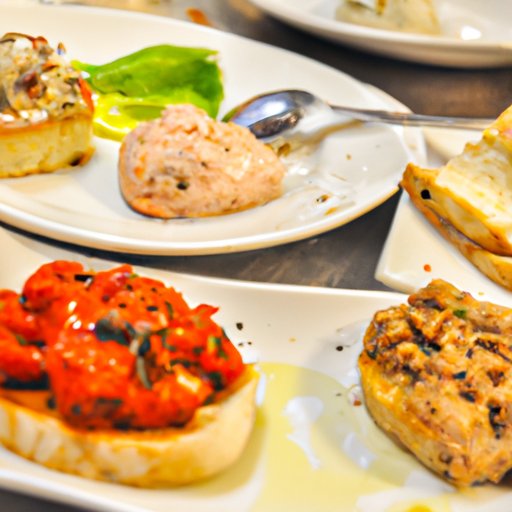Introduction
When it comes to delicious and comforting food, few cuisines can rival that of Italy. From pizza and pasta to risotto and gelato, Italian cuisine is beloved around the world for its unique flavors and hearty ingredients. But is Italian food actually healthy? In this article, we’ll explore the nutritional values of classic Italian dishes, compare them to other cuisines, and offer some tips on making Italian cuisine healthier.

Exploring the Health Benefits of Italian Cuisine
Italian cuisine is based on a Mediterranean diet, which is widely regarded as one of the healthiest diets in the world. At its core, the Mediterranean diet emphasizes fresh fruits and vegetables, whole grains, legumes, nuts, fish, and healthy fats like olive oil. Many traditional Italian dishes are packed with these nutritious ingredients, making them excellent sources of fiber, vitamins, minerals, and antioxidants.
One of the most popular Italian dishes is pizza, which is often loaded with cheese, tomatoes, and meats. While pizza can be unhealthy if it’s loaded with fatty toppings, it can also be a great source of protein and vitamins if you choose the right toppings. For example, adding vegetables like bell peppers or mushrooms can boost the nutritional value of your pizza without sacrificing any flavor.
Pasta is another Italian staple, and it’s usually made from durum wheat flour, which is high in fiber and B vitamins. Whole-wheat pasta is even better, since it contains more fiber and other nutrients. When selecting sauces for your pasta, look for ones made with olive oil and fresh vegetables, as these will be lower in fat and calories than those made with cream or butter.
Risotto is another Italian favorite, and it’s typically made with Arborio rice, which is a type of short-grain rice. Risotto is a good source of complex carbohydrates, and when cooked with vegetables and broth, it can provide a good balance of protein, fiber, and vitamins.

The Pros and Cons of Eating Italian Food
As with any cuisine, there are both pros and cons to eating Italian food. On the plus side, Italian food is generally very flavorful and satisfying, and it’s usually made with fresh and wholesome ingredients. It’s also very versatile, so you can easily make healthy substitutions like swapping white pasta for whole-wheat pasta or adding vegetables to your pizza.
On the downside, Italian cuisine can be high in fat and calories, especially when it’s prepared with rich cheeses, heavy sauces, and fried foods. Italian desserts like gelato and cannoli are also very indulgent, and they should be enjoyed in moderation. Additionally, Italian dishes often contain lots of salt, so it’s important to watch your sodium intake when eating Italian food.

Comparing the Nutritional Values of Italian vs. Other Cuisines
Compared to other cuisines, Italian food is generally considered to be fairly nutritious. However, it’s important to note that the nutritional value of Italian dishes can vary greatly depending on the region. For example, northern Italian cuisine tends to be heavier on dairy products and rich sauces, while southern Italian dishes are typically lighter and healthier.
When comparing Italian cuisine to other cuisines, it’s important to consider how the dishes are prepared. For instance, Japanese food is often made with fresh ingredients and low-fat cooking methods, so it can be a healthier option than Italian food. Similarly, Indian food often relies on spices and herbs to add flavor, rather than relying on cream and butter.
At the end of the day, it’s important to remember that all cuisines have their own unique nutritional values, and it’s up to you to find the right balance of flavors and ingredients that works best for your lifestyle.
Healthy Alternatives to Popular Italian Foods
If you’re looking for ways to make your Italian dishes healthier, there are several simple substitutions you can make. For example, instead of using white pasta, opt for whole-wheat pasta or gluten-free alternatives like quinoa or buckwheat pasta. You can also add more vegetables to your dishes, like zucchini or eggplant, or try using leaner proteins like chicken or turkey instead of beef or pork.
When it comes to sauces, look for ones that are made with olive oil and fresh herbs, rather than cream or butter. You can also reduce the amount of cheese you use, or opt for low-fat varieties. Finally, when it comes to desserts, try to limit yourself to a small portion of gelato or cannoli and choose fruit-based desserts when possible.
Conclusion
In conclusion, Italian food can be a nutritious and delicious part of your diet, as long as you’re mindful of the ingredients you’re using. By exploring the nutritional values of traditional Italian dishes and finding healthier alternatives to common ingredients, you can enjoy the flavors of Italy without compromising your health.
For further exploration, check out our blog posts on the health benefits of Italian cuisine or consult with a registered dietitian for tailored advice on incorporating Italian dishes into your diet.
(Note: Is this article not meeting your expectations? Do you have knowledge or insights to share? Unlock new opportunities and expand your reach by joining our authors team. Click Registration to join us and share your expertise with our readers.)
